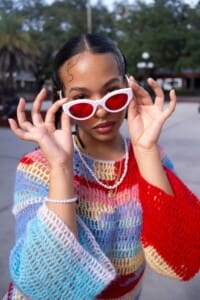
Written by Patrickia Duncan
Remember the fashion craze of low-rise jeans, graphic tees, and bright Juicy Couture tracksuits? Remember blingy belts, silk scarves, and bootcut jeans? The accessories, the butterfly clips, and the flashy gold hoop earrings are all back — back like they never left.
This time, Gen Z is giving the early 2000s aesthetic a modern twist. Chunky Converse platforms, athleisure wear, and crop tops are now a staple in wardrobes. While Gen Z is embracing the practicality of today’s trends, there’s also nostalgia. Whether it’s Y2K fashion (clothing trends from the early 1990s and the early 2000s), thrifting, or fast fashion, this generation is embracing the old and making it new again. But, what’s fueling the obsession with the past, what’s fueling the resurgence of vintage styles, and what does it say about today’s fashion culture?

Fashion has always been recurring, with trends recurring every 20 years, but the Y2K comeback feels different. It’s not just about copying and pasting what’s been done in the past, it’s about reinventing. Think of a scientist conducting an original study. Now think of another scientist revisiting that study two decades later, refining and reshaping it with new information. Similarly, Gen Z is reinventing the 2000s fashion, blending nostalgia and modern approaches to create something entirely on their own.
The truth is the early 2000s similar to how the ‘90s was a big hit in the 2010s, Y2K is now dominating social media platforms, runways, and streetwear. What was once seen as ‘cringe’ fashion — layering dresses over jeans or even Adam Sandler’s signature oversized outfits is now considered fresh and exciting. If Adam Sandler can prove you don’t need designer clothes to have an iconic look, then the proof is in the pudding; Y2K fashion is all about accessibility, comfort, and digital influence.
With social media platforms and digital influence, TikTok, Instagram, and Pinterest have played a major role in making Y2K fashion mainstream. Many influencers are mimicking styles once rocked by Destiny’s Child or Britney Spears, encouraging them to shine a light on the trend. Viral hashtags such as #Y2KFashion and #Y2Kaesthetic have gained traction and inspired many Gen Z watchers to have a thrill in their parent’s closets in search of authentic vintage finds.
Unlike millennials, Gen Z is approaching Y2K fashion with an interesting perspective. You’d think young people would consider their parent’s clothing “out of style” but young people see early 2000s pieces such as vintage Coach bags or Ed Hardy t-shirts as collectible gems. These items are more than just clothing, they represent time.

With gender-fluid dressing, mix-and-match aesthetics, and disregard of strict fashion rules, Y2K is proving that creativity is timeless. The trend is breaking boundaries. Celebrities like A$AP Rocky, Bad Bunny, and Harry Styles are rocking pieces that were once considered feminine. They wear plaid skirts, lace-trimmed dresses, and crop tops, further proving fashion is more fluid than ever. 2025 is the time to be bold, expressive, and experiment with fashion. Why fit in, when you can stand out?
TV shows, movies, and music videos have also played a major role in shaping Y2K fashion. Films such as Mean Girls made mini-skirts, form-fitting dresses, and slogan crop tees a must-have. Shows such as That’s So Raven embraced bold colors, funky layering, and statement accessories which have left a mark today.
Similarly, characters and figures from Monster High and Bratz Dolls focused on edgy looks which featured dramatic makeup and platform boots. For shows like these, being “weird” or “different” is considered cool and Gen Z took that message to heart. Music icons like Christina Aguilera defined low-rise jeans and bedazzled crop tops. Embracing similar aesthetics and creating inspo for daily looks like these reinterprets these styles in a modern lens. Fashion trends like these are used to express identity, fun, and confidence.These pop culture movements not only define style but prove Y2K culture isn’t just another phase.
With Y2K, major retailers have also mass-produced these pieces. Fast fashion brands such as Shein, PrettyLittleThing, and Hollister have flooded the market with Y2K-inspired clothing. According to Adad Garcia, a manager at Hollister’s Edison store, the brand has noticed fluctuations in different inspired styles. “There are always new styles that are trending. For example baggy jeans and crop tops. We have gone back to the early ‘90s and 2000s fashion in the past; low rise ‘90s jeans, ultra high rise jeans, dad jeans, etc.” This shift highlights how trend cycles move faster than anticipated with Hollister capitalizing nostalgia.

While stores like Hollister have adapted to producing trendy pieces, not all customers turn to fast fashion. For many Gen Z consumers, the thrill of trends lies in thrift stores. Secondhand shopping offers something that fast fashion cannot: authenticity. Purchasing newly manufactured Y2K pieces feels like a crime for some. Gen Z shoppers prefer the real deal– actual clothing from the 2000s. The shift has led to a drastic increase in name-brand purses, flared jeans, and rhinestone studded tops which can be found at thrift stores for a reasonable price.
Beyond the thrill of sifting through racks, sustainability also plays an important role in thrifting. With fast fashion, there are often growing concerns about waste, overproduction, and labor conditions. On the other hand, many young shoppers are turning to thrift as a way to shop for original clothing while learning about how fast fashion affects the planet.
Social media has also been beneficial for promoting thrifting for goodies and emphasizing vintage finds. Hashtags such as #ThriftedY2K have gained popularity with content creators and users showing off graphic baby tees and low-rise jeans they’ve scored for only a few dollars.
Still, thrifting isn’t everyone’s cup of tea. While some love the idea of discovering hidden gems at their leisure, others prefer retail stores where they buy exactly what they need in a jiffy, making it easier to find.
As the Y2K trend continues, it’s clear that this trend is more than a phase- it’s a cultural movement driven by nostalgia, self-expression, and reinvention. Whether through mass-produced fashion or good ol’ thrifting, Gen Z has embraced the 2000s aesthetic and has not only honed its aesthetic but curated it into something new.
For some, it’s all about convenience and accessibility, with brands like Hollister making Y2K-inspired pieces easy to find. For others, authenticity and sustainability become a priority, pushing shoppers toward thrift stores for one-of-a-kind finds. The debate between fast fashion and thrifting reflects a shift in how shoppers approach their style. The balance between trendiness and individuality stands on its own.
As fashion cycles continue to persevere, it begs the question: what’s next? If history is making its way around town, one thing is for certain: Gen Z isn’t just focused on wearing “what’s cool” and following trends, they want to rewrite the rules.

